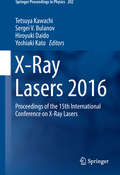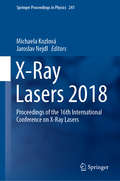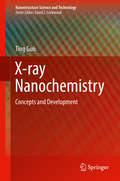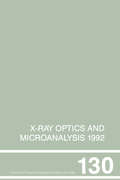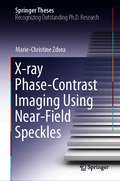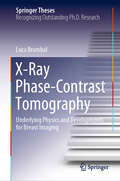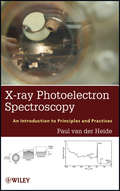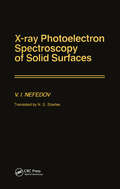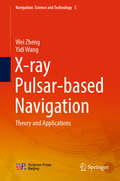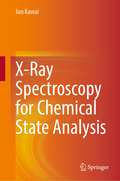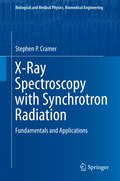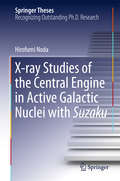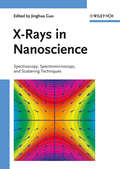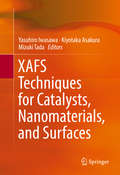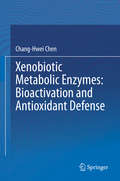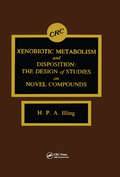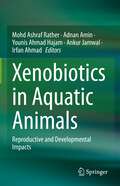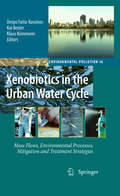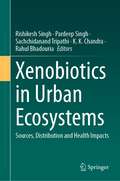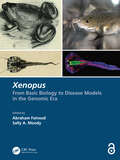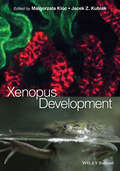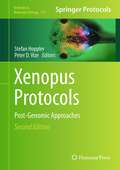- Table View
- List View
X-Ray Lasers 1996: Proceedings of the Fifth International Conference on X-Ray Lasers held in Lund, Sweden, 10-14 June, 1996
by S Svanberg; C-G WahlströmX-Ray Lasers 1996 provides not only an overview and progress report on this fast moving field, but also important reference material on which future work can be built. Topics covered include collisional x-ray lasers, table-top x-ray lasers, beam optics, x-ray optics, OFI and photo-pumped schemes, capillary schemes, international laser facilities, XUV nonlinear mixing, alternative soft x-ray sources, diagnostics, and applications. The volume is an essential addition to the libraries of researchers in the field.
X-Ray Lasers 2016: Proceedings Of The 15th International Conference On X-ray Lasers (Springer Proceedings In Physics #202)
by Tetsuya Kawachi Sergei V. Bulanov Hiroyuki Daido Yoshiaki KatoDiscusses the latest research topics related to coherent x-ray sources.<P><P> Includes several new proposals for free-electron laser (FEL) using laser- accelerated electrons.<P> Describes the latest methodology and techniques for x-ray coherent diffraction imaging and x-ray interferometry.<P> These proceedings comprise a selection of invited and contributed papers presented at the 15th International Conference on X-Ray Lasers (ICXRL 2016), held at the Nara Kasugano International Forum, Japan, from May 22 to 27, 2016. This conference was part of an ongoing series dedicated to recent developments in the science and technology of x-ray lasers and other coherent x-ray sources with additional focus on supporting technologies, instrumentation and applications. <P> The book showcases recent advances in the generation of intense, coherent x-rays, the development of practical devices and their applications across a wide variety of fields. It also discusses emerging topics such as plasma-based x-ray lasers, 4th generation accelerator-based sources and higher harmonic generations, as well as other x-ray generation schemes.
X-Ray Lasers 2018: Proceedings of the 16th International Conference on X-Ray Lasers (Springer Proceedings in Physics #241)
by Michaela Kozlová Jaroslav NejdlThese proceedings gather a selection of invited and contributed papers presented during the 16th International Conference on X-Ray Lasers (ICXRL 2018), held in Prague, Czech Republic, from 7 to 12 October 2018. The conference is part of an ongoing series dedicated to recent developments in the science and technology of X-ray lasers and other coherent X-ray sources, with an additional focus on supporting technologies, instrumentation and applications. The book highlights advances in a wide range of fields including laser and discharge-pumped plasma X-ray lasers, the injection and seeding of X-ray amplifiers, high-order harmonic generation and ultrafast phenomena, X-ray free electron lasers, novel schemes for (in)coherent XUV, X-ray and γ-ray generation, XUV and X-ray imaging, optics and metrology, X-rays and γ-rays for fundamental science, the practical implementation of X-ray lasers, XFELs and super-intense lasers, and the applications and industrial uses of X-ray lasers.
X-ray Nanochemistry: Concepts And Development (Nanostructure Science And Technology Ser.)
by Ting GuoThis book describes the latest developments in the new research discipline of X-ray nanochemistry, which uses nanomaterials to enhance the effectiveness of X-ray irradiation. Nanomaterials now can be synthesized in such a way as to meet the demand for complex functions that enhance the X-ray effect. Innovative methods of delivering the X-rays, which can interact with those nanomaterials much more strongly than energetic electrons and gamma rays, also create new opportunities to enhance the X-ray effect. As a result, new concepts are conceived and new developments are made in the last decade, which are discussed and summarized in this book. This book will help define the discipline and encourage more students and scientists to work in this discipline. These efforts will eventually lead to formation of a full set of physical, chemical and materials principles for this new research field.
X-Ray Optics and Microanalysis 1992, Proceedings of the 13th INT Conference, 31 August-4 September 1992, Manchester, UK
by P.B. Kenway P.J. DukeThe first ICXOM congress held in Cambridge was the brain-child of Dr. Ellis Cosslett, founder of the Electron Optics Section of the Cavendish Laboratory. Dr. Cosslett pioneered research in x-ray optics and microanalysis and retained a close interest in all subject applications for this area of research, including physics, materials science, chemistry, and biology. X-Ray Optics and Microanalysis 1992 was held in his memory. At a special symposium, friends and colleagues reviewed the present status of research in x-ray optics and microanalysis. S.J. Pennycook of Oak Ridge National Laboratory, D.B. Williams of Lehigh University, J.A. Venables et al. of Arizona State University and Sussex University, and C. Jacobsen et al. of SUNY, Stony Brook are among the researchers whose papers are included in this volume.
X-ray Phase-Contrast Imaging Using Near-Field Speckles (Springer Theses)
by Marie-Christine ZdoraThis thesis presents research on novel X-ray imaging methods that improve the study of specimens with small density differences, revealing their inner structure and density distribution. Exploiting the phase shift of X-rays in a material can significantly increase the image contrast compared to conventional absorption imaging. This thesis provides a practical guide to X-ray phase-contrast imaging with a strong focus on X-ray speckle-based imaging, the most recently developed phase-sensitive method. X-ray speckle-based imaging only requires a piece of abrasive paper in addition to the standard X-ray imaging setup. Its simplicity and robustness combined with the compatibility with laboratory X-ray sources, make it an ideal candidate for wide user uptake in a range of fields. An in-depth overview of the state of the art of X-ray speckle-based imaging and its latest developments is given in this thesis. It, furthermore, explores a broad range of applications, from X-ray optics characterisation, to biomedical imaging for 3D virtual histology and geological studies of volcanic rocks, demonstrating is promising potential. Moreover, the speckle-based technique is placed in the context of other phase-sensitive X-ray imaging methods to assist in the choice of a suitable method, hence serving as a guide and reference work for future users.
X-Ray Phase-Contrast Tomography: Underlying Physics and Developments for Breast Imaging (Springer Theses)
by Luca BrombalX-ray imaging is a corner stone of breast cancer diagnosis. By exploiting the phase shift of X-rays rather than their attenuation, phase-contrast tomography has the potential to dramatically increase the visibility of small and low contrast features, thus leading to better diagnosis. This thesis presents research on the first synchrotron-based project developing a clinical phase-contrast breast computed tomography (CT) setup at Elettra, the Italian Syncrotron Radiation Facility. This book includes a comprehensive theoretical background on propagation-based phase-contrast imaging, exploring and extending the most recent image formation models. Along with theory, many practical implementation and optimization issues, ranging from detector-specific processing to setup geometry, are tackled on the basis of a large number of experimental evidences. Most of the modelling results and data analysis have general validity, being a valuable framework for optimization of phase-contrast setups. Results obtained at synchrotron are also compared with "real world" laboratory sources: both a first-of-its-kind comparison with one of the few hospital breast CT systems and a state-of-the-art implementation of monochromatic phase-contrast micro-tomography with a conventional rotating anode source are presented. On a more general level, this work sheds a light on the importance of synchrotron-based clinical programs, which are key to trigger the long-anticipated transition of phase-contrast imaging from synchrotrons to hospitals.
X-ray Photoelectron Spectroscopy
by Paul van der HeideThis book introduces readers interested in the field of X-ray Photoelectron Spectroscopy (XPS) to the practical concepts in this field. The book first introduces the reader to the language and concepts used in this field and then demonstrates how these concepts are applied. Including how the spectra are produced, factors that can influence the spectra (all initial and final state effects are discussed), how to derive speciation, volume analysed and how one controls this (includes depth profiling), and quantification along with background substraction and curve fitting methodologies. This is presented in a concise yet comprehensive manner and each section is prepared such that they can be read independently of each other, and all equations are presented using the most commonly used units. Greater emphasis has been placed on spectral understanding/interpretation. For completeness sake, a description of commonly used instrumentation is also presented. Finally, some complementary surface analytical techniques and associated concepts are reviewed for comparative purposes in stand-alone appendix sections.
X-Ray Photoelectron Spectroscopy of Solid Surfaces
by V.I. NefedovThis volume outlines the physical and methodical concepts of X-ray photoelectron spectroscopy (XPS) specifically for surface studies using both inner and valence electron levels. It discusses the theory and practice of XPS qualitative and quantitative analysis of solid state surfaces and provides lists of extended experimental and theoretical data necessary for the determination of concentration and thin film thicknesses. In addition it covers the many problems concerning in-depth profiling, ion sputtering rate and damages of the structure of altered layers, as well as applications of angular dependence of the intensities and photoelectron diffraction for surface studies. Also provided are the applications of XPS for the investigations of catalysts, adsorption, electronic surface states, oxydation of semi-conductors and alloys, minerals, including lunar regolith and natural gold, glasses, radiation damage, surface diffusion, polymers, etc.
X-ray Pulsar-based Navigation: Theory and Applications (Navigation: Science and Technology #5)
by Wei Zheng Yidi WangThis book discusses autonomous spacecraft navigation based on X-ray pulsars, analyzing how to process X-ray pulsar signals, how to simulate them, and how to estimate the pulse’s time of arrival based on epoch folding. In turn, the book presents a range of X-ray pulsar-based spacecraft positioning/time-keeping/attitude determination methods. It also describes the error transmission mechanism of the X-ray pulsar-based navigation system and its corresponding compensation methods. Further, the book introduces readers to navigation based on multiple measurement information fusion, such as X-ray pulsar/traditional celestial body integrated navigation and X-ray pulsar/INS integrated navigation. As such, it offers readers extensive information on both the theory and applications of X-ray pulsar-based navigation, and reflects the latest developments in China and abroad.
X-Ray Spectroscopy for Chemical State Analysis
by Jun KawaiThis book focuses on X-ray spectroscopy for chemical state analysis covering X-ray physics, spectroscopic characteristics used for functional and toxic materials, and the author's ideas related to X-ray experiments. This book also provides novel theoretical interpretations of X-ray spectra along with experimental techniques needed for both synchrotron radiation users and laboratory experimentalists. Presenting not only practical information, this book also covers basic knowledge of commercially available spectrometers and the basic physics of optics and electromagnetism related to X-rays. Furthermore, the author introduces the forgotten history of X-ray physics in the beginning of twentieth century. This book is of use for researchers studying catalysts, charge-transfer materials, surface characterization, and toxic trace elements via X-ray spectroscopy for chemical state analysis as well as quantitative analysis.
X-Ray Spectroscopy with Synchrotron Radiation: Fundamentals and Applications (Biological and Medical Physics, Biomedical Engineering)
by Stephen P. CramerSynchrotron radiation has been a revolutionary and invaluable research tool for a wide range of scientists, including chemists, biologists, physicists, materials scientists, geophysicists. It has also found multidisciplinary applications with problems ranging from archeology through cultural heritage to paleontology. The subject of this book is x-ray spectroscopy using synchrotron radiation, and the target audience is both current and potential users of synchrotron facilities. The first half of the book introduces readers to the fundamentals of storage ring operations, the qualities of the synchrotron radiation produced, the x-ray optics required to transport this radiation, and the detectors used for measurements. The second half of the book describes the important spectroscopic techniques that use synchrotron x-rays, including chapters on x-ray absorption, x-ray fluorescence, resonant and non-resonant inelastic x-ray scattering, nuclear spectroscopies, and x-ray photoemission. A final chapter surveys the exciting developments of free electron laser sources, which promise a second revolution in x-ray science. Thanks to the detailed descriptions in the book, prospective users will be able to quickly begin working with these techniques. Experienced users will find useful summaries, key equations, and exhaustive references to key papers in the field, as well as outlines of the historical developments in the field. Along with plentiful illustrations, this work includes access to supplemental Mathematica notebooks, which can be used for some of the more complex calculations and as a teaching aid. This book should appeal to graduate students, postdoctoral researchers, and senior scientists alike.
X-ray Studies of the Central Engine in Active Galactic Nuclei with Suzaku
by Hirofumi NodaThe aim of this research was to use the X-ray satellite Suzaku to establish a picture of a central engine that effectively converts the gravitational energy of accreting matter onto the supermassive black hole to a huge amount of radiation in an active galactic nucleus. Although the engine is known to consist of a Comptonizing corona and an accretion disk, its image has remained unclear because primary emissions, coming directly from the engine, cannot be identified in X-ray spectra without models. The book describes a technique of time variability assisted spectral decomposition to model-independently examine X-ray signals, and how this was applied to the Suzaku archive data of active galactic nuclei. As a result, at least three distinct primary X-ray components have been discovered in an X-ray from an active galactic nucleus, presumably indicating a novel picture that the engine is composed of multiple coronae with different physical properties in an accretion flow. Furthermore, the determination of the spectral shapes of the primary X-rays has a significant impact on estimations of black hole spins, because it is essential to quantify reprocessed X-ray spectra. The successful model-independent decomposition of X-ray spectral components with flux variations of active galactic nuclei is likely to be effective in future data analyses from the soon-to-be-launched Japanese X-ray satellite ASTRO-H, which is capable of achieving unprecedented fine spectros copy and broad energy band coverage.
X-Rays and Extreme Ultraviolet Radiation
by David Attwood Sakdinawat Anne Geniesse Linda Anne Sakdinawat Linda GeniesseThis detailed, comprehensive book describes the fundamental properties of soft X-rays and extreme ultraviolet (EUV) radiation and discusses their applications in a wide variety of fields, including EUV lithography for semiconductor chip manufacture and soft X-ray biomicroscopy. The author begins by presenting the relevant basic principles such as radiation and scattering, wave propagation, diffraction, and coherence. He then goes on to examine a broad range of phenomena and applications. The topics covered include spectromicroscopy, EUV astronomy, synchrotron radiation, and soft X-ray lasers. The author also provides a wealth of useful reference material such as electron binding energies, characteristic emission lines and photo-absorption cross-sections. The book will be of great interest to graduate students and researchers in engineering, physics, chemistry, and the life sciences. It will also appeal to practising engineers involved in semiconductor fabrication and materials science.
X-Rays in Nanoscience: Spectroscopy, Spectromicroscopy, and Scattering Techniques
by Jinghua GuoAn up-to-date overview of the different x-ray based methods in the hot fields of nanoscience and nanotechnology, including methods for imaging nanomaterials, as well as for probing the electronic structure of nanostructured materials in order to investigate their different properties. Written by authors at one of the world's top facilities working with these methods, this monograph presents and discusses techniques and applications in the fields of x-ray scattering, spectroscopy and microscope imaging. The resulting systematic collection of these advanced tools will benefit graduate students, postdocs as well as professional researchers.
x+y: A mathematician's manifesto for rethinking gender
by Eugenia ChengScience and maths have never been the preserve of lone geniuses: collaboration has always been at the heart of intellectual endeavour. But to this day, men like Einstein remain the pervasive archetype of genius, and the intellectual contributions of women past and present have gone unacknowledged. x+y is one mathematician's manifesto for how we can fix that - and why that requires rethinking how we think about thinking itself.In her illuminating new book, Royal Society Book Prize finalist Eugenia Cheng reveals how mathematics can help us escape gendered stereotypes by giving us new structures based on character, not gender. By reframing intellectual endeavour beyond the myth of the lone genius, she shows that the real key to success is thinking more collaboratively. Through her radical new framework for understanding traditional ideas about gender and thinking, Cheng shows us how one small but powerful change to the way we think could make the world a better place for men and women alike.
XAFS Techniques for Catalysts, Nanomaterials, and Surfaces
by Yasuhiro Iwasawa Kiyotaka Asakura Mizuki TadaThis book is a comprehensive, theoretical, practical, and thorough guide to XAFS spectroscopy. The book addresses XAFS fundamentals such as experiments, theory and data analysis, advanced XAFS methods such as operando XAFS, time-resolved XAFS, spatially resolved XAFS, total-reflection XAFS, high energy resolution XAFS, and practical applications to a variety of catalysts, nanomaterials and surfaces. This book is accessible to a broad audience in academia and industry, and will be a useful guide for researchers entering the subject and graduate students in a wide variety of disciplines.
Xenobiotic Metabolic Enzymes: Bioactivation And Antioxidant Defense
by Chang-Hwei ChenThis book provides a comprehensive, organized, and concise overview of xenobiotic metabolic enzymes and their health implications. The subjects addressed are broad in scope with an emphasis on recent advances in research on biochemical and biomedical aspects of these enzymes. The xenobiotics discussed include not just drugs, but also food, smoke, and other environmental chemicals. The subjects covered in this work include: metabolic enzymes and their catalyzed reactions, reactive intermediates generated from metabolic activation, oxidative stress mediated by electrophilic reactive intermediates, bioactivation - mediated cellular and functional damages, activation of Nrf2 – ARE pathway, genetic variations affecting metabolic enzyme expression, enzyme polymorphisms affecting xenobiotic - mediated toxicity, induction of metabolic enzymes for health benefits, and a diversity of metabolic enzyme modulators.
Xenobiotic Metabolism and Disposition: The Design of Studies on Novel Compounds
by Harry P.A. IllingThis publication explains the principles of the techniques used in disposition and metabolism studies in animals, in man, and in vitro. It includes methods for studying routes and rates of absorption, distribution, metabolism, and excretion of novel compounds and their metabolites. Relevant surgical, whole-body autoradiographic and pharmacokinetic procedures are discussed, together with techniques for separating and identifying metabolites and metabolic path-ways. Information on when the procedures are appropriate, and examples of what they represent, are presented in order to illustrate the value of such studies.
Xenobiotics in Aquatic Animals: Reproductive and Developmental Impacts
by Mohd Ashraf Rather Adnan Amin Younis Ahmad Hajam Ankur Jamwal Irfan AhmadThis book summarizes the latest understanding of the impact of xenobiotics on the developmental and reproductive processes of aquatic animals, particularly nektonic forms, which comprise an important group of aquatic ecosystems. Aquaculture is quickly becoming the largest contributor of fish protein for human consumption. As the aquaculture business expands, farmed fish will be exposed to more environmental toxins, necessitating the use of chemical therapeutic drugs for fish. This book brings together experts on the regulation of environmental toxins and food chemicals from around the world, as well as researchers looking into the metabolism and disposal of foreign chemicals (xenobiotics) in fish species. The impact of xenobiotics on reproductive and developmental biology of all living forms has become of prime importance at the current time. As the effect of these xenobiotics on aquatic animals is an emerging area for research and development, several groups across the world are working on these aspects, targeting different groups of fishes in both marine and freshwater ecosystems. This collective work highlights several key and updated recent aspects of different types of xenobiotics entering aquatic ecosystems, impacts of these agents on reproductive physiology, developmental biology, breeding biology, hormonal imbalance, aquatic ecology, and pollution on the aquatic ecosystem. The unique aggregation of different types of stressors to aquatic animals under a single volume will be a useful reference for readers, including scientists, teachers, students, researchers and policymakers and those involved in aquaculture and environment conservation.
Xenobiotics in the Urban Water Cycle
by Klaus Kümmerer Kai Bester Despo Fatta-KassinosThe presence of xenobiotics in the aquatic environment is seen as one of the biggest challenges for a sustainable water future. Thus, there is a need to understand, in an integrated manner, the sources, flow paths, fate and effects of xenobiotics in the urban water cycle. This book is an authoritative and comprehensive reference source covering: occurrence, sources and fluxes of xenobiotics in urban waters, processes concerning the fate and transport of xenobiotics, mass flows and transformation products, mitigation, treatment methods and systems for the removal of xenobiotics, risk assessment methodologies and risk management, information on source control and mitigation measures. The book contains a wealth of information on some of the compounds most frequently found in urban water systems, and of special interest will be the chapters dealing with compounds that have only recently been investigated, such as illicit drugs, scents, and toxins.
Xenobiotics in Urban Ecosystems: Sources, Distribution and Health Impacts
by Rishikesh Singh Pardeep Singh Sachchidanand Tripathi K. K. Chandra Rahul BhadouriaThis volume provides state-of-the-art knowledge on xenobiotics in urban ecosystems, addressing a wide range of related issues, such as xenobiotic types and chemical composition, environmental fate, remedial approaches, regulatory policies and socioeconomic impacts. The book incorporates theoretical and practical aspects pertaining to xenobiotics to assess their threat level in urban environments, while determining appropriate responses and remediation measures to curb harmful impacts and prevent future contaminations. The book will be of interest to soil scientists, ecological engineers, agriculturists, urban policymakers, students and researchers working in the field of urban agriculture and environmental sciences.
Xenopus: From Basic Biology to Disease Models in the Genomic Era
by Abraham Fainsod Sally A. MoodyThis book focuses on the amphibian, Xenopus, one of the most commonly used model animals in the biological sciences. Over the past 50 years, the use of Xenopus has made possible many fundamental contributions to our knowledge in cell biology, developmental biology, molecular biology, and neurobiology. In recent years, with the completion of the genome sequence of the main two species and the application of genome editing techniques, Xenopus has emerged as a powerful system to study fundamental disease mechanisms and test treatment possibilities. Xenopus has proven an essential vertebrate model system for understanding fundamental cell and developmental biological mechanisms, for applying fundamental knowledge to pathological processes, for deciphering the function of human disease genes, and for understanding genome evolution. Key Features Provides historical context of the contributions of the model system Includes contributions from an international team of leading scholars Presents topics spanning cell biology, developmental biology, genomics, and disease model Describes recent experimental advances Incorporates richly illustrated diagrams and color images Related Titles Green, S. L. The Laboratory Xenopus sp. (ISBN 978-1-4200-9109-0) Faber, J. & P. D. Nieuwkoop. Normal Table of Xenopus laevis (Daudin): A Systematical & Chronological Survey of the Development from the Fertilized Egg till the End of Metamorphosis (ISBN 978-0-8153-1896-5) Jarret, R. L. & K. McCluskey. The Biological Resources of Model Organisms (ISBN 978-1-0320-9095-5)
Xenopus Development
by Jacek Z. Kubiak Malgorzata KlocFrogs from the genus Xenopus have long been used as model organisms in basic and biomedical research. These frogs have helped unlock key fundamental developmental and cellular processes that have led to important scientific breakthroughs and have had practical application in embryology, cancer research and regenerative medicine. Xenopus Development is a vital resource on the biology and development of these key model organisms, and will be a great tool to researchers using these frogs in various disciplines of biological science.Xenopus Development is divided into four sections, the first three highlight key processes in Xenopus development from embryo to metamophosis. These sections focus on the cellular processes, organogenesis and embryo development. The final section highlights novel techniques and approaches being used in Xenopus research.Providing thorough and detailed coverage, Xenopus Development, will be a timely and welcome volume for those working in cell and molecular biology, genetics, developmental biology and biomedical research.Provides broad overview of the developmental biology of both Xenopus laevis and Xenopus tropicalisExplores cellular to systems development in key biomedical model organismsTimely synthesis of the field of Xenopus biologyHighlights key biomedical and basic biological findings unlocked by Xenopus
Xenopus Protocols
by Stefan Hoppler Peter D VizeDuring the 20th century Xenopus has flourished as an accessible experimental model system for studying vertebrate biology. The second edition of Xenopus Protocols:Post-Genomic Approaches expands upon the previous edition with novel approaches inspired by Xenopus tropicalis and the sequencing of its genome. Xenopus tropicalis genomics and tractable genetics combined with the unique experimental advantages of Xenopus laevis and their distinctive phylogenetic position make them unique model systems for vertebrate embryonic development in the 21st century. Written in the highly successful Methods in Molecular BiologyTM series format, chapters include introductions to their respective topics, lists of the necessary materials and reagents, step-by-step, readily reproducible laboratory protocols, and key tips on troubleshooting and avoiding known pitfalls. Authoritative and practical, Xenopus Protocols: Post-Genomic Approaches, Second Edition provides a toolkit that will enable every laboratory to maximize the power of this extraordinary experimental system in the post-genomic age.

